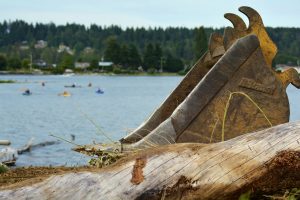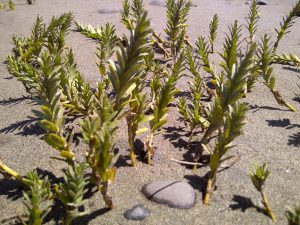[av_textblock size=” font_color=” color=”]

Fish and Wildlife are loving the new digs down at the Courtenay Airpark. You can check the new digs in person or virtually via the photos and drone video below.
 This June Project Watershed, with funding and assistance from The Fish and Wildlife Compensation Program, Recreational Fisheries Conservation Partnerships Program, North American Partnership for Environmental Community Action, and the City of Courtenay, installed a culvert below the Riverway Walk at the North end of the lagoon. The culvert brings fresh water from the river in to the upper lagoon area. The river water is cool helping keep the lagoon’s temperature within a range habitable for salmonids and other species. It also increases mixing along the water column which keeps nutrients dispersed and replenishes oxygen making the lagoon and especially the upper lagoon better habitat for fish and wildlife. And it seems to be working.
This June Project Watershed, with funding and assistance from The Fish and Wildlife Compensation Program, Recreational Fisheries Conservation Partnerships Program, North American Partnership for Environmental Community Action, and the City of Courtenay, installed a culvert below the Riverway Walk at the North end of the lagoon. The culvert brings fresh water from the river in to the upper lagoon area. The river water is cool helping keep the lagoon’s temperature within a range habitable for salmonids and other species. It also increases mixing along the water column which keeps nutrients dispersed and replenishes oxygen making the lagoon and especially the upper lagoon better habitat for fish and wildlife. And it seems to be working.
Post project monitoring reports show that the water quality has improved and many fish and bird species have been reported using the lagoon including the upper area where the culvert has been installed. While no salmonids have been spotted yet it is anticipated that many juveniles will appear next spring.
Project Watershed would like to remind everyone that this is a fish and wildlife thoroughfare not a human one. While kayakers and stand up paddle boarders are welcome to investigate the culvert from the riverside it is asked that they do not enter the culvert. “We want to keep people safe and the culvert free for the fish and wildlife it was designed to help,” said Project Watershed Director Dan Bowen.
The banks surrounding the culvert may look a bit bare as some of the plants had to be moved for the work to progress. To help revegetate the area Project Watershed will be replanting native vegetation next spring. This is an important step as this is a sensitive area that is prone to erosion. You can do your part to help mitigate erosion by keeping yourself and/or your dog off the banks especially on the lagoon side. “It may look like a great place to throw a stick for Fido but it would be better to use the boat launch or another more stable area,” suggests Project Watershed Chair and dog owner Paul Horgen.
 Another component of this project was to build salt marsh habitat which are gravel islands or beds (shown at the beginning of the drone video below) – one in the lagoon and two south of the lagoon near the sheltered bridge. As part of the process the few preexisting salt marsh plants in the area were salvaged and then replanted on the new gravel beds. The plants have taken root and are doing well. However, there were not enough plants so the islands will remain partially bare until next spring. Planting is best done in the spring as it is the best growing season and there are less storms to uproot the plants. Specific salt marsh plants have been selected and are currently being raised at Streamside Native Plants. They are being purchased through a Walmart Evergreen Grant.
Another component of this project was to build salt marsh habitat which are gravel islands or beds (shown at the beginning of the drone video below) – one in the lagoon and two south of the lagoon near the sheltered bridge. As part of the process the few preexisting salt marsh plants in the area were salvaged and then replanted on the new gravel beds. The plants have taken root and are doing well. However, there were not enough plants so the islands will remain partially bare until next spring. Planting is best done in the spring as it is the best growing season and there are less storms to uproot the plants. Specific salt marsh plants have been selected and are currently being raised at Streamside Native Plants. They are being purchased through a Walmart Evergreen Grant.
These salt marshes will complement the culvert by providing habitat, food, and refuge for the increased amount of fish and wildlife using the area. They will provide connectivity between the lagoon and estuary habitats and help to stabilize the shoreline. In addition to these benefits salt marshes are blue carbon ecosystems and some of the best sequesterers of carbon on the planet – win, win, win!
[/av_textblock]
[av_video src=’https://youtu.be/AhE4K_nmj8U’ format=’16-9′ width=’16’ height=’9′]
Working with the K’ómoks Nation towards Q’waq’wala7owkw on their unceded territory.

